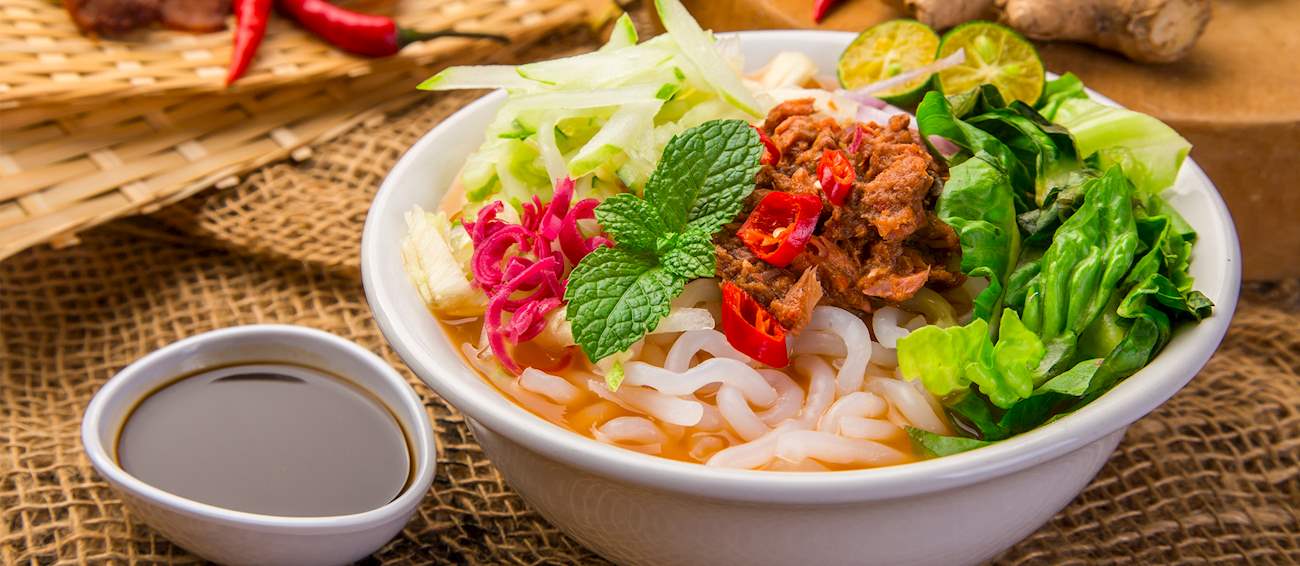Best Penangese Foods
Char kway teow is one of the most popular street dishes in Malaysia and Singapore. Despite numerous regional varieties, it is usually made with flat rice noodles, shrimps, eggs, cockles, bean sprouts, chives, and Chinese sausage. All the ingredients are usually fried and coated in soy sauce, while some versions also incorporate shrimp paste, garlic, fried pork lard, and sometimes even yellow wheat noodles.
Among the numerous theories about the origin of the dish, the most popular claims that it was invented in the Singaporean Teochew community by Chinese immigrants, while the name stems from Hokkien, char meaning fried and kway teow denoting flat rice noodles.
MAIN INGREDIENTS
The perfect blend of spicy, sweet, savory, and umami flavors, penang laksa is a popular Malaysian street food, originating from the north-western state of Penang. This hearty noodle soup is made with poached mackerel (or sardines), tamarind, lemongrass, and chili peppers as the base ingredients.
Other commonly used garnishes include ginger flower buds, pineapple slices, onions, mint, and shrimp paste (hae ko). But, regardless of all the specific recipes, the result is always a rich and strong-flavored dish that has earned the adoration of both locals and travelers alike.
OTHER VARIATIONS OF Laksa
Penang version of the dish known as Hokkien mee is significantly different from the varieties that can be found in other parts of Malaysia and Singapore. Often referred as prawn mee, the dish consists of a broth that is flavored with prawns and pork ribs, and which comes topped with ingredients such as sliced pork, rice and wheat noodles, bean sprouts, prawns, kangkong (water spinach), fried shallots, and boiled eggs.
This hawker classic is usually served with a chili-based sauce. As the name suggests, the origins of the dish are among the Hokkien community who emigrated from Chinese province of Fujian.
These Malaysian buns were invented at the namesake bakery in Penang. First marketed as Mexican coffee buns, they consist of a leavened dough that is filled with butter and topped with a layer of coffee-infused buttercream. During baking, the cream top completely covers the bun and creates a thin, crispy coffee layer.
The Mexican conchas allegedly inspired the bun, hence its original name. Soon after they were introduced in 1998, the buns were an instant success. Nowadays, the franchise has spread throughout Asian and Arab countries, and their signature bun is better known as rotiboy or roti kopi.
This classic Malaysian dish combines steamed rice and an assortment of different curries, sides, and condiments. The rice is occasionally seasoned, and the choice of curries includes various combinations of vegetables, meat, or seafood. Traditionally associated with Penang, the dish was initially developed among the Indian community who brought their culinary traditions to Malaysia.
They used to sell and transport the dish using traditional kandar bamboo sticks, eventually giving the dish its current name. Nowadays, nasi kandar is usually prepared and sold at hawker centers across the country and is traditionally enjoyed as a nutritious, warm breakfast.
Lam mee is a traditional dish of Nyonya people. It's made by cooking yellow rice noodles in a gravy made from the stock of prawns and chicken or pork ribs. The gravy is the real star of this dish, with a great mix of seafood flavors from the prawns and sweetness coming from the pork ribs.
Once prepared, the dish is topped with prawns, pork ribs, chives, shallots, and shredded eggs. The standard accompaniment for lam mee is sambal belacan, a condiment consisting of lime juice, salt, sugar, and red chili peppers. In Penang, this dish is typically served for birthdays as it symbolizes longevity.
TasteAtlas food rankings are based on the ratings of the TasteAtlas audience, with a series of mechanisms that recognize real users and that ignore bot, nationalist or local patriotic ratings, and give additional value to the ratings of users that the system recognizes as knowledgeable. TasteAtlas Rankings should not be seen as the final global conclusion about food. Their purpose is to promote excellent local foods, instill pride in traditional dishes, and arouse curiosity about dishes you haven’t tried.






